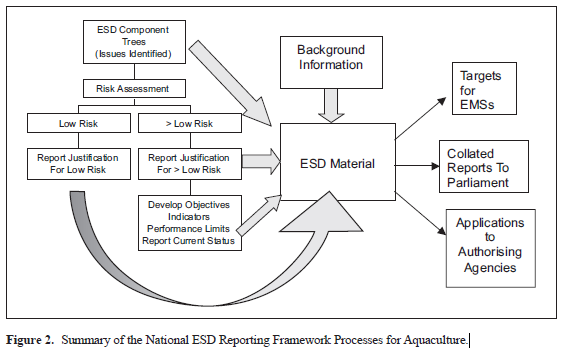
Solutions for Fisheries
A. Aquaculture
- The increasing trend to aquaculture is one example of a short-term solution that is slowly on the rise. Aquaculture, or aquafarming, is the cultivation of marine or freshwater food fish under controlled conditions. In 2009, aquaculture contributed 50 percent of total fish consumed globally (Stanford 2009)
- However, there are serious questions as to the indefinite sustainability of aquaculture, especially with the proliferation of disease, weaker stocks, eutrophication of coastal zones, disruption of biological environments, negative effects from escaped farmed organisms ("World Fisheries" 2006).
- The FAO recommends an ecosystem approach to aquaculture (EAA): An ecosystem approach to aquaculture (EAA) strives to balance diverse societal objectives, by taking account of the knowledge and uncertainties of biotic, abiotic and human components of ecosystems including their interactions, flows and processes and applying an integrated approach to aquaculture within ecologically and operationally meaningful boundaries. The purpose of EAA should be to plan, develop and manage the sector in a manner that addresses the multiple needs and desires of societies, without jeopardizing the options for future generations to benefit from the full range of goods and services provided by aquatic ecosystems (FAO 2010).
- The FAO in its report on Fisheries and Aquaculture describes the implementation of specific decision-making tools at the farm level and at the industry level as well as discussing the proper geographic scale of aquaculture zones. Australia is one cited example as a country that has developed a good ecosystem approach to aquaculture (FAO 2010). They have developed an approach using an Ecologically Sustainable Development (ESD) framework that uses 5 key elements: (1) identifying issues relevant to the industry/sector, (2) prioritizing these issues, (3) developing detailed reports and management strategies specific to the situations risk and complexity, (4) creating a background report on the environmental industry, the major species and environments affected, and (5) using this material to then assist individuals, industries, and agencies on specific courses of action (Fletcher et al., 2004).

B. Decrease the size of the fishing fleet by 10 percent
- Considering that the current size of the fishing fleet is double what it needs to be to produce the same yield ("World Fisheries" 2006), we believe that a 10 percent reduction is a significant start over the next 10 years. Although sources vary, we claim that this first step will act as a sustainable, permanent action that can then be scaled up over later years. See Alternative Livelihood section.
- Part of this decrease comes by mandating a redistribution of the given subsidies to the fishing industry. Currently the industry receives 5,000,000,000 USD more than they generate in revenue ("World Fisheries" 2006). The ideal solution would be to cut subsidies themselves; however because fishing plays such an important role in country's economies and food supplies, this is simply not realistic. A much more effective plan would be to redistribute how much money of the subsidies received must go toward ecosystem and fisheries management. In 2006, only 7 billion USD of the total 26 billion USD in worldwide subsides were spent on conservation, while the rest went to increasing the fishing fleet. (Sumaila and Pauly 2006). Redistributing this cost would be a more effective way to allow both ecosystem management as well as support the fishing industry.
C. Marine Protected Areas
- The most substantial long-term solution is the development of sustainable marine protected areas (MPAs). An MPA , according the 1994 World Conservation Union, is "an area of sea dedicated to the protection and maintenance of biological diversity and of natural and associated cultural resources, and managed through legal or other effective means" ("Marine Protected Areas" 2010)


